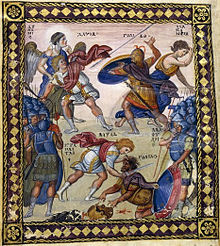
Back مخطوطات بيزنطية مزخرفة Arabic Bizantijski iluminirani rukopisi BS Byzantinische Buchmalerei German Enluminure byzantine French Miniatura bizantina Italian

Byzantine illuminated manuscripts were produced across the Byzantine Empire, some in monasteries but others in imperial or commercial workshops. Religious images or icons were made in Byzantine art in many different media: mosaics, paintings, small statues and illuminated manuscripts.[1] Monasteries produced many of the illuminated manuscripts devoted to religious works using the illustrations to highlight specific parts of text, a saints' martyrdom for example, while others were used for devotional purposes similar to icons. These religious manuscripts were most commissioned by patrons and were used for private worship but also gifted to churches to be used in services.[2]

Not all Byzantine illuminated manuscripts were religious texts, secular subjects are represented in chronicles (e.g. Madrid Skylitzes), medical texts such as the Vienna Dioscurides, and some manuscripts of the Greek version of the Alexander Romance. In addition to the majority of manuscripts, in Greek, there are also manuscripts from the Syriac Church, such as the Rabbula Gospels, and Armenian illuminated manuscripts which are heavily influenced by the Byzantine tradition.[3]
"Luxury" heavily-illuminated manuscripts are less of a feature in the Byzantine world than in Western Christianity, perhaps because the Greek elite could always read their texts, which was often not the case with Latin books in the West, and so the style never became common. However, there are examples, both literary (mostly early) and religious (mostly later).
The Byzantine iconoclasm paused production of figural art in illuminated manuscripts for many decades, and resulted in the destruction or mutilation of many existing examples.[3]
Combined there are 40.000 Byzantine manuscripts extant today but most are not illuminated.
- ^ Cormack, Robin (2000). Byzantine art. Oxford: Oxford University Press. ISBN 9780192842114. OCLC 43729117.
- ^ The Oxford Dictionary of Byzantium. Kazhdan, A. P. (Aleksandr Petrovich), 1922-1997., Talbot, Alice-Mary Maffry., Cutler, Anthony, 1934-, Gregory, Timothy E., Ševčenko, Nancy Patterson. New York: Oxford University Press. 1991. ISBN 9780195187922. OCLC 62347804.
{{cite book}}: CS1 maint: others (link) - ^ a b BL
© MMXXIII Rich X Search. We shall prevail. All rights reserved. Rich X Search